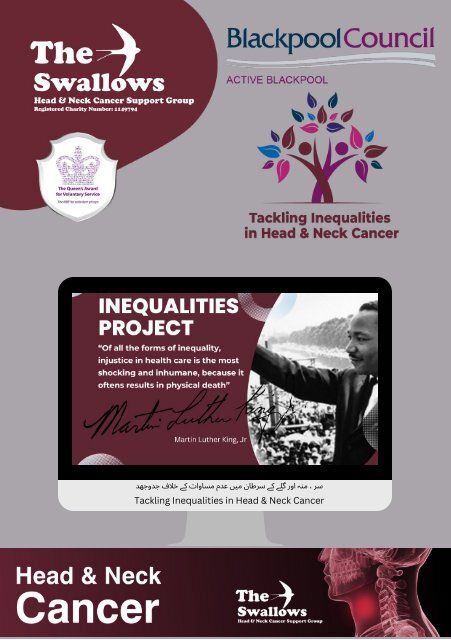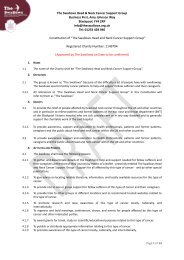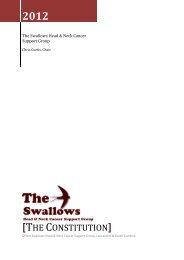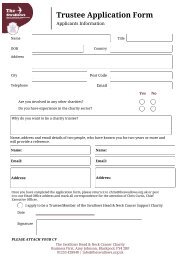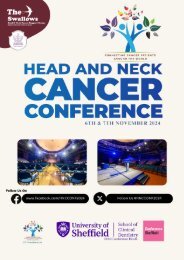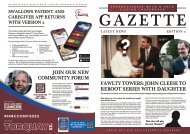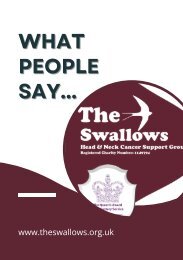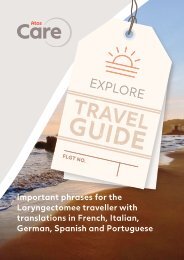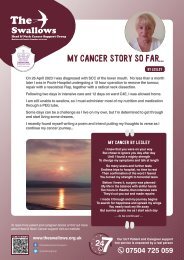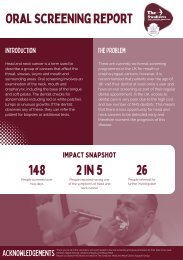Inequalities Update Report
Edition 1
Edition 1
- No tags were found...
Create successful ePaper yourself
Turn your PDF publications into a flip-book with our unique Google optimized e-Paper software.
سر ، منہ اور گلے کے سرطان میں عدم مساوات کے خلاف جدوجھد<br />
Tackling <strong>Inequalities</strong> in Head & Neck Cancer
Project Overview<br />
Mission Statement<br />
“To ensure everyone, whatever their<br />
ethnicity, is aware of Head and Neck<br />
Cancer, the signs to look for, how, where<br />
to seek diagnoses and where to go for<br />
Key metrics<br />
support and help.<br />
Creating awareness for early diagnosis in<br />
all societies could save lives and go a long<br />
way in helping the NHS reach point 4 of<br />
the Core20/Plus5 target **75% of cases<br />
diagnosed at stage 1 or 2 by 2028’’<br />
To educate our young people who can<br />
inform their elders. Importantly, young<br />
people are the next generation of<br />
patients who will come through the NHS<br />
cancer system and be the target<br />
population for our goal of helping the<br />
NHS hit there 2025 target of 75%<br />
diagnosed at stage 1 or 2<br />
75%<br />
Diagnosed at stage 1 or 2<br />
12 MONTH<br />
Project<br />
CHALLENGES<br />
Underlying socioeconomic factors like education, unemployment<br />
and poverty are clear factors contributing to health inequalities.<br />
However, evidence shows that structural racism leads to people<br />
from ethnic minority backgrounds having poorer health<br />
outcomes.<br />
In all broad ethnic groups, head & neck cancer is the fourth most<br />
common cancer type.<br />
Asian, Black, and Mixed ethnic backgrounds have higher rates of<br />
cancer for most cancer types, compared to White people.<br />
A small number of cancer types are more common in certain<br />
ethnic groups compared with White people, including head & neck<br />
cancer (Oral, Nasopharyngeal, Larynx, Tongue), myeloma and<br />
stomach cancer in Black people, gallbladder cancer in Black and<br />
Asian people, and prostate cancer in Black men.<br />
LIFE STYLES<br />
Smoking, Smoking styles, Chewing Tabacco, Eating Paan, Eating<br />
Supari, Obesity. Lifestyles are the main preventable causes of<br />
cancer, and have historically been higher in Non-White groups.<br />
WHY DO DIFFERENCES EXIST?<br />
The differences in cancer incidence between people from<br />
different ethnic backgrounds are largely driven by non-genetic<br />
cancer risk factors such as: -<br />
Main Factors<br />
Language Barriers, Culture, Education, Screening takeup.<br />
Changing Behaviour<br />
The key aim of this pilot involves working on changing behaviour<br />
by engaging with the young community and educating them about<br />
the dangers of Head & Neck Cancer, the signs to look for,<br />
addressing engagement in screening programmes, and<br />
encouraging them to take the message back to their wider<br />
community.<br />
www.theswallows.org.uk<br />
68-70 Waterloo Road, Blackpool, FY4 1AB
Project Overview<br />
LITERARY<br />
Literary is connected to books or formal writing. An example of<br />
literary used as an adjective is the phrase literary magazine, a<br />
magazine about writing, as such we need to be aware of this when<br />
writing material.<br />
Our solution is to address this in the early working groups with<br />
Young People and see what they say about this, it is also<br />
important they help with the design and colour of any material.<br />
We must also consider the impact of current trends in digital<br />
media/messages and if this would be a better option.<br />
WORKING GROUPS<br />
We will create working parties to help design, create and<br />
distribute all materials.<br />
FACTS & FIGURES<br />
1<br />
Racial Health <strong>Inequalities</strong>
Project Overview<br />
Our project aims to use a range of different approaches to tackling Health <strong>Inequalities</strong> in head and<br />
neck cancer across Blackpool and Blackburn with Darwen to contribute to the Core20Plus5 target of<br />
75% of cancer cases diagnosed at stage 1 or 2 by 2028.<br />
EDUCATION<br />
The burden of Head & Neck Cancer (HNC) is strongly<br />
socioeconomically patterned, with the highest rates being<br />
observed among people living in the most socioeconomically<br />
deprived communities, such as Blackpool. To address the lack of<br />
knowledge around the signs and symptoms and influential risks of<br />
HNC we aim to educate young people using sport and physical<br />
activity as a vehicle to engage with the intended audience.<br />
Initially we will do some consultation with young people to<br />
ensure that our plans, educational and marketing material will be<br />
suitable to have the highest level of impact. We hope that by<br />
educating young people, they will have the lifelong knowledge to<br />
recognise the signs and symptoms and educate and support their<br />
families and peers in the future.<br />
BAME 1 COMMUNITIES<br />
The overall incidence of HNC continues to rise, with a predicted<br />
30% increase annually by 2030. Ethnically diverse communities<br />
have a particularly high incidence of oral cancer, associated with<br />
chewing of areca nut (betel quid), with or without tobacco. With<br />
35.7% of the population of Blackburn with Darwen from an Asian<br />
ethnic group, it gives us a great opportunity to work within the<br />
heart of the community to do some targeted work to raise<br />
awareness of the signs and symptoms, educate about potential<br />
cultural risks and carry out oral screenings.<br />
PREHAB & REHAB<br />
Racial Health <strong>Inequalities</strong><br />
The evidence is growing to support the role of physical activity<br />
during and after cancer treatment. Keeping active throughout the<br />
cancer journey can preserve or improve physical function and<br />
psychological well-being, reducing the negative impact of some<br />
cancer related side-effects. Regular physical activity also has a<br />
potential role in reducing risk of cancer recurrence and<br />
increasing survival. Active Blackpool aim to use this pilot as an<br />
opportunity to introduce prehab and rehab for cancer into their<br />
Exercise Referral pathway by raising awareness of the benefits of<br />
physical activity on a patient cancer journey, providing<br />
information leaflets and home based equipment and deliver<br />
online and in person classes with a specialised L4 Cancer<br />
Rehabilitation instructor.
Project Overview<br />
1<br />
Benefit One<br />
A pilot for change<br />
2<br />
Benefit Two<br />
Delivering equitable change in the inequalities of Head & Neck Cancer<br />
3<br />
4<br />
Benefit Three<br />
NHS Core20|Plus5 Target: Early Cancer Diagnosis ~ 75% of cases<br />
diagnosed at stage 1 or 2 by 2028<br />
Benefit Four<br />
19 year old student in 2022 will be 25 in 2028, maybe married and living with the same<br />
culture and lifestyles<br />
"It is time for Changing Behaviour & Education" Chris Curtis, Head & Neck Cancer<br />
Survivor, Chief Executive Officer of the Swallows Head & Neck Cancer Charity.<br />
Research<br />
Referrals<br />
Research has shown us that the following languages should be in the Pilot Project.<br />
Demographic Population<br />
1. Gujurati<br />
2. Bengali<br />
3. Punjabi<br />
4. Urdu<br />
5. Mandarin<br />
Research Tools<br />
1. Regain study in Warwick chose the above<br />
2. Census 2021 (latest demographics available)<br />
3. Previous attended Health Mela conferences<br />
1. Health Professionals (Hospital Oncology Teams)<br />
2. Health Professional (Local GP's & Dentists & Community Nurses)<br />
3. Local Libraries<br />
4. Sport Centres<br />
5. Universities – Educate young people to help educate the elders<br />
6. Local Authorities<br />
7. Health Watch<br />
8. Local Community Groups<br />
9. Local Business Owners<br />
10. Health Mela Teams<br />
11. Hospital Community Teams<br />
12. Community Shops<br />
13. Community Hubs<br />
14. Place of Worship
Project Overview<br />
EXAMPLE CHANGES<br />
کیا آپ کو پتا ہے کے مندرجہ ذیل چیزیں منہ کے سرطان کا خطرہ بڑھا سکتی ہیں⸮<br />
URDU<br />
پان کھانا<br />
سپاری، چھالیہ ، گٹکا وغیرہ چبانا<br />
تمباکو چبانا<br />
شراب پینا<br />
سگرٹ پینا<br />
TRANSLATION<br />
Do You know you have an increased chance of getting oral cancer? If you are,<br />
Chewing Paan?<br />
Chewing Supari?<br />
Chewing Tobacco?<br />
Drink Alcohol?<br />
Smoking?<br />
منہ کے سرطان کی جلد شناخت آپ کی زندگی بچا سکتی ھے<br />
Oral cancer if detected early has an increased chance of survivorship.
Project Overview<br />
Education<br />
آگاہی<br />
تعلیم<br />
Awareness<br />
1<br />
Ignorance<br />
سمجھ<br />
لاعلمی<br />
My Understanding<br />
۔ تہذیب<br />
Culture<br />
سر ، منہ اور گلے کے سرطان میں عدم مساوات کے خلاف جدوجھد<br />
Tackling <strong>Inequalities</strong> in Head & Neck Cancer
Project Overview<br />
Mission Statement<br />
“To ensure everyone, whatever their<br />
ethnicity, is aware of Head and Neck<br />
Cancer, the signs to look for, how, where<br />
to seek diagnoses and where to go for<br />
support and help.<br />
Creating awareness for early diagnosis in<br />
all societies could save lives and go a<br />
long way in helping the NHS reach point<br />
4 of the Core20/Plus5 target **75% of<br />
cases diagnosed at stage 1 or 2 by 2028’’<br />
PROJECT LEAD<br />
The Swallows Head & Neck Cancer Charity<br />
68-70 Waterloo Road<br />
South Shore<br />
BLACKPOOL<br />
Lancashire<br />
FY4 1AB<br />
01253 428 940<br />
www.theswallows.org.uk<br />
info@theswallows.org.uk<br />
Charity Number: 1149794<br />
Contact<br />
Christopher Curtis<br />
Chief Executive Officer, H&N Cancer Survivor<br />
chris@theswallows.org.uk<br />
07779 169 833<br />
PROJECT COLLABRATION<br />
Blackpool Active<br />
Laura Ivinson<br />
Jenifer Fairfield<br />
Neil Pimlott<br />
FUNDING STAKEHOLDERS<br />
NHS Core20|Plus5~ Cancer Research Northwest ~ Lancashire and<br />
South Cumbria Cancer Alliance ~ NHS Lancashire & South<br />
Cumbria Integrated Care Board<br />
STAKEHOLDERS<br />
Lancaster University Health School ~ UCLAN ~ Crellin Counselling<br />
~ Fylde College ~ NFHW Health Mela - Blackpool NHS Hospital<br />
OTHER PARTNERS<br />
BizAsialLive TV ~ Lyca Gold Radio
<strong>Inequalities</strong> Project<br />
<strong>Update</strong><br />
WHAT HAVE WE<br />
ACHIEVED...<br />
Conducted Market Research<br />
Buiding strong relationships<br />
Appointment of a young student<br />
Mobile Application
Conduct Market<br />
Research<br />
Worked with Lancaster, Blackburn,<br />
Blackpool Universities, carried out a Survey<br />
on the understanding of Head & Neck<br />
Cancer.<br />
Build Strong<br />
Relationships<br />
Built relationships with Key Opioin Leaders<br />
such as Health Professionals, Universities,<br />
Schools, Reseach specialists.<br />
Appointed a local student<br />
(Intermship)<br />
Working with a young student of the team<br />
has helped us gain an insight in to the<br />
importance of young peoples opinions.<br />
Collabration<br />
We are collabrating with other NHS teams<br />
who are working on inequalities of Head &<br />
Neck Cancer and sharing ideas and results.<br />
01<br />
02<br />
03<br />
04
So<br />
Achievements<br />
Far<br />
HIGHLIGHT<br />
FILM<br />
CREATED A FILM TO<br />
EXPLAIN THE PROJECT<br />
DISTRIBUTED THE FILM VIA<br />
SOCIAL MEDIA,<br />
UNIVERSITIES<br />
https://youtu.be/ffB5i39trkg<br />
SURVEY
So<br />
Achievements<br />
Far<br />
HIGHLIGHT<br />
SURVEY RESULTS<br />
56% of respondents to the survey from social media<br />
were in the target age group of the project 18-25.
So<br />
Achievements<br />
Far<br />
HIGHLIGHT<br />
ORAL<br />
SCREENING
YOUNG PERSONS<br />
THOUGHTS<br />
Key actionable changes to adapt awareness material to a younger<br />
audience<br />
Following interviewing three young people from different backgrounds about their<br />
thoughts on the awareness material, these are the changes that could be made to the<br />
material to adapt it to a younger audience.<br />
·Use of pictures of young people instead of adults in the posters to target it to the<br />
correct audience<br />
·Reduce amount of text and increase size of text. Less text is better and then perhaps<br />
more information could be available via weblink and QR code (not everyone can access<br />
QR codes on their phone)<br />
·Brighter colours to be more eye-catching. Mention of the blue and green being eyecatching<br />
so maybe a different colour scheme for the materials associated with this<br />
campaign as an almost sub-brand?<br />
·Bold fonts are effective.<br />
·Poster comes across as ‘aimed at everyone old and young’ and young people may<br />
disregard as doesn’t feel specific to them so suggestion of facts and figures that are<br />
specific to young people so they know its and issue concerning them. ‘Although if it is<br />
trying to be aimed at a young audience, it needs to address that there is an issue with<br />
young people getting this type of cancer’<br />
·More colours and images vs text.<br />
·Statistics should be tailored for target audience.<br />
·Could include more targeted stats about young people’s risks/images that seem more<br />
relatable
Examle Worksheet A<br />
HEAD CANCERHEAD AND NECK CANCER<br />
How would you best describe your knowledge and understanding of head and<br />
neckcancers? (Tick one)<br />
What is your understanding of HPV (Human Papillomavirus)? (tick one)<br />
Have you been vaccinated against HPV?<br />
I have never heard of head and neck cancers prior to this survey<br />
I have heard of head and neck cancers but don't know much about them<br />
I know the signs and symptoms of head and neck cancers<br />
I know someone who had been diagnosed with head and neck cancer.<br />
I have never heard of HPV prior to this survey<br />
I have heard of HPV but don't know much about it<br />
I know the signs and symptoms of HPV infection and how it is transmitted<br />
Yes<br />
No<br />
I'm not sure<br />
Prefer not to say<br />
Created a series of Worksheets for<br />
the educational events


